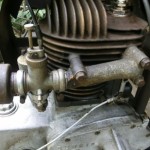Forum Replies Created
-
AuthorPosts
-
October 1, 2022 at 7:38 am #40039
 wristpinParticipant
wristpinParticipantWhile we are on the subject of gaskets, it’s as well to consider that as well as their sealing function they may perform a “spacing function”, as in setting the amount of pre-load on a bearing or shaft. Substituting “stuff from a tube” for a crankcase or gearbox cover, may result in the loss of required end float and a tight engine or gearbox.
Then there is their use to insulate, such as to reduce heat transfer. For example ,anyone who worked on Aspera vertical shaft engines in the 50s/60s will remember those thick gaskets between the cylinder block and the long right angle inlet manifold – the one that worked loose and attributed to difficult starting!September 30, 2022 at 8:03 am #40036 wristpinParticipant
wristpinParticipantSeveral years ago I bought an assorted pack of A4 sheets of gasket material ranging from cork, through various thicknesses of different materials – Klinger Statite, Interface, Tesnit, Flexoid & Klingersil etc. Great to have to hand when the need arises – usually at a weekend when the shops are shut, not that there any places left around here that sell engineering supplies etc.
If needs must, don’t forget the breakfast cereal box, won’t do a head gasket but is a get out of trouble for less critical applications !!September 28, 2022 at 5:48 pm #40030 wristpinParticipant
wristpinParticipantProper gasket material, no stuff in a tube – neutral or otherwise!
September 28, 2022 at 4:15 pm #40028 wristpinParticipant
wristpinParticipantEngine. Villiers Lightweight – probably the 150 cc version, but other than the capacity ( bore diameter)the same as the 125cc. Hope that it’s not full of water !
September 23, 2022 at 8:15 pm #39990 wristpinParticipant
wristpinParticipantThanks, I’ll give it another go. AS
September 10, 2022 at 11:56 pm #39941 wristpinParticipant
wristpinParticipantAmerica went over to unleaded fuel way before us, and all their small engine manufacturers were using hardened valve seats well ahead of us. They also offered the option positive valve rotation for certain constant speed applications such as generators and pumps. Your engine was made years before the introduction of ethanol adulterated fuel so go for the lowest E number available in your area.
Your possible time / heat related failure may not be ignition related. When it stops, push it straight into a shaded area, disconnect the plug lead, remove the plug, hold the lead 1/4” away from the head or head shield, and rotate the engine with the recoil. If you get a spark, look elsewhere – valve clearances perhaps.
There are a couple of eBay sellers for Meco units, but the Nova one seems to be favoured by Kohler users.
When considering replacing a conventional points and condenser system with an “electronic” trigger module, I like to have the engine running satisfactorily before the conversion. That way, one can be fairly sure that the coil etc are sound.
In the light of your issues with the flywheel nut, have you checked that the flywheel hasn’t shifted on the crank – sheared or partially sheared key?September 10, 2022 at 1:52 pm #39935 wristpinParticipant
wristpinParticipantStay away from E10 for as long as you can – stick with E5 or even ethanol free if you can get it.
The ignition trigger unit that you illustrate is what is often marketed in the UK as a Nova, and it’s fine for your Kohler. I happen to prefer the Meco as it’s smaller and easier to hide within a flywheel magneto.
Assuming that your Kohler’s coil has two small diameter wires in addition to the HT lead, one will usually be the low tension lead that normally runs across the back of the engine to the points and the other may be an earth/ground. If it only has one small diameter wire, it is the low tension wire which should be attached to one terminal of the trigger unit. I don’t think that it is polarity sensitive, so its other terminal is grounded. If it doesn’t work, swap them over. I have, in the past, found that the insulation on the low tension wire cracked, and shorted out where it runs across the back of the block under its securing clip.
The trigger unit replaces both the points and the condenser, so there should be just one low tension wire from the coil to the unit – unless there is also a handle-bar mounted kill switch, which will have a connection to the low tension / module wire and a ground. If your machine has a kill switch, I would check all its wiring for shorts to ground / earth – or disconnect it – remembering that you will need to short the plug out to stop it!!
As far as your chewed up crank thread goes, I would be inclined to cut off the offending bit, counter drill and thread it to take as big a set screw as the diameter of the crank will safely accommodate. Coarse thread, big washer and Loctite !September 7, 2022 at 4:44 pm #39923 wristpinParticipant
wristpinParticipantTwo possible suppliers for used plates come to mind. Martyn Channer, so has a presence on eBay and Upsons, near Maldonado, Essex.
September 5, 2022 at 9:23 pm #39915 wristpinParticipant
wristpinParticipantFrom what I remember of Model aircraft fuel it would certainly have good penetrating / searching properties, even when past being suitable for its intended purpose. As far as proprietary dismantling potions go, Plus Gas has been my go to product for many years but some people favour a mix of automatic transmission fluid and acetone. For assemblies that need a good soak, I have a 25 litre topless drum of red diesel; ideal for seized Ransomes Marquis rear rollers which have never failed to yield after a week long soak – as yet !
September 5, 2022 at 8:07 am #39910 wristpinParticipant
wristpinParticipantSo I carefully sanded out the lips so I had flat plates again and whilst at it had the clutch plates re-lined.
No experience of the the MT cutter drive but assuming correct assembly, the answer must lie in the re-lining. Presumably the firm entrusted with that operation were either given a specification to work to or purported to know the specification?
The starting point needs to be the correct specification of the friction plates; a ten thou thickness of friction material does seem a bit thin but spread over 11 plates may have been adequate
Hopefully Doe can help, even just one plate that can be measured may supply the answer. A complete set of plates will be “ gold dust” but I dread to guess the price.August 27, 2022 at 1:36 pm #39858 wristpinParticipant
wristpinParticipantIf governor springs are not strong enough, maybe chainsaw or trimmer centrifugal clutch springs. I had a similar issue finding springs for a British Anzani Powermow clutch. Took a bit of experimenting and even now not 100%.
August 27, 2022 at 7:38 am #39856 wristpinParticipant
wristpinParticipantUnfortunately, none of my Aspera parts books go back far enough to include an engine with the flyball governor, so I’m unable to assist with part numbers. Hopefully someone else has an earlier parts manual.
August 26, 2022 at 2:17 pm #39855 wristpinParticipant
wristpinParticipantGood luck with finding parts, I would start with Jon Cruse at the Hailsham Mower Centre. After that , hopefully an Aspera specialist on this forum will come to the rescue. Meanwhile I’ll see whether I have anything with part number info.
Starting issue – is the choke closing fully?August 26, 2022 at 8:22 am #39840 wristpinParticipant
wristpinParticipantProgress! You appear to have sorted the starter and the outstanding issue is the governor. It appears to be of the “ flyball” type and I’ve never seen one , let alone worked on one, but it would seem to be as shown in the manual as the” Flyball type governor on V51 and AH51 and I hope that you can relate the attached image to what is in front of you. As I see it, The principle would appear to be that the throttle is held permanently open via a spring ( the governor spring) attached to an adjustable/bendable anchor. A link connected to the flyball mechanism under the flywheel exerts a closing force as the speed increases.
Hope that this helps.-
This reply was modified 3 years, 3 months ago by
 wristpin.
wristpin.
August 25, 2022 at 7:30 pm #39839 wristpinParticipant
wristpinParticipantLets start with a model number and an image or two. Otherwise it’s guess work.
-
This reply was modified 3 years, 3 months ago by
-
AuthorPosts




